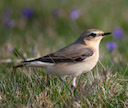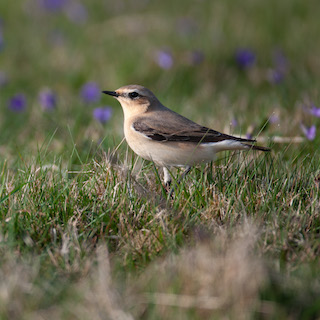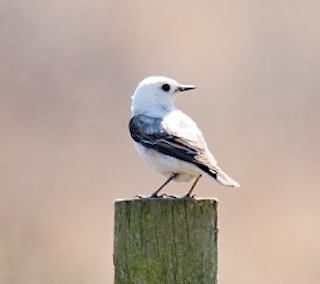 Wheatears are summer visitors to Britain, and in July you can often spot juveniles born in the same year, as well as the striking adults.
Wheatears are summer visitors to Britain, and in July you can often spot juveniles born in the same year, as well as the striking adults.
Photo: © Richard Birchett
Scientific name: Oenanthe oenanthe
Other common names: Northern Wheatear, Common Wheatear, European Wheatear
Conservation status: British Birds of Conservation Concern, Amber (due to a trend of declining numbers in Britain and Europe); IUCN Red List, Least Concern.
What to look for:
- Colouring and appearance: Mature male birds (lower photograph this page) have a summer plumage of black wings, black cheeks, a rusty-coloured breast, grey upper parts and white underparts. Look for the obvious white rump with black ‘T’ marking in flight. In winter, they resemble the females, which are paler brown above, with buff underparts. Juvenile birds are paler and speckled (see top photograph).
- Size: Up to 16 cm in length, a little larger than a Robin.
- Where: A summer visitor from Africa, look for it in the north and west of Britain on moorland and heaths. Fewer pairs breed in the southeast, though it may be spotted round the coast.
- Call: Whistles and clicking; its song is fast and chirpy.
- Similar species: The Whinchat, which has a more orange breast and a more prominent white eye stripe.
 The Wheatear’s genus name (Oenanthe) is shared with a family of plants: the Water Dropworts. Oenanthe is derived from the Greek for wine flower, referring to the scent of the Dropwort flowers, but its use as the generic name for the Wheatears refers to their arrival in Greece each year at the same time as the grapevines begin to bloom.
The Wheatear’s genus name (Oenanthe) is shared with a family of plants: the Water Dropworts. Oenanthe is derived from the Greek for wine flower, referring to the scent of the Dropwort flowers, but its use as the generic name for the Wheatears refers to their arrival in Greece each year at the same time as the grapevines begin to bloom.
The Northern Wheatear (usually referred to simply as Wheatear) is a migratory bird, overwintering in sub-Saharan Africa but heading north in the spring to arrive in Britain and Ireland, and as far north as Canada, Alaska and Greenland. It boasts one of the longest migrations for a smaller bird, crossing oceans in some cases to reach Canada and Greenland: this can take an impressive 30 hours of non-stop flying over 2,400 km.
Some 230,000 pairs arrive and breed in Britain in the spring. Look for this ground-dweller hopping along the ground, chasing after its insect prey. Eggs are laid in clutches of five to six between late April and mid-June, and pairs often raise two or even three broods during the summer. Nests are cup-shaped, and built from leaves, lichen, hair and feathers, usually placed in a vacant animal burrow or hole in the rocks.
Did you know…?
…It may seem odd that a bird that prefers stony open ground is named Wheatear. In fact, its name is a corruption of its original and rather cheeky name of ‘White-arse’ (referring to its white rump), nothing to do with wheat at all.
…Why do Wheatears migrate such a long way? After the last ice-age, their breeding grounds moved north as the climate warmed, but they still migrate all the way back to Africa.
…A leucistic Wheatear was spotted at Windmill Farm on the Lizard in early April 2015. Leucism, which turns an animal’s fur or feathers completely or partially white, is the result of defective pigmentation cells. Leucistic birds lack some pigmentation, and so have areas of partial white colouring. You can distinguish this from the much rarer albinism by eye colouring, which is pink in the latter, but remains the original darker colouring in leucistic individuals. The leucistic Wheatear in the photo below was spotted by Dougy Wright at Windmill Farm.

More information and references:
Svensson, L., Mullarney, K., Zetterstrom, D.,1986. Collins Bird Guide, second edition (translated by Christie, D., Svensson, L.). HarperCollins, London.
Published: July 2014 (updated March 2020)
Author: Amanda Scott
Photos: © Richard Birchett (upper: Wheatear at Kynance Cove in spring 2020); Dougy Wright (lower: leucistic Wheatear at Windmill Farm in spring 2015)
